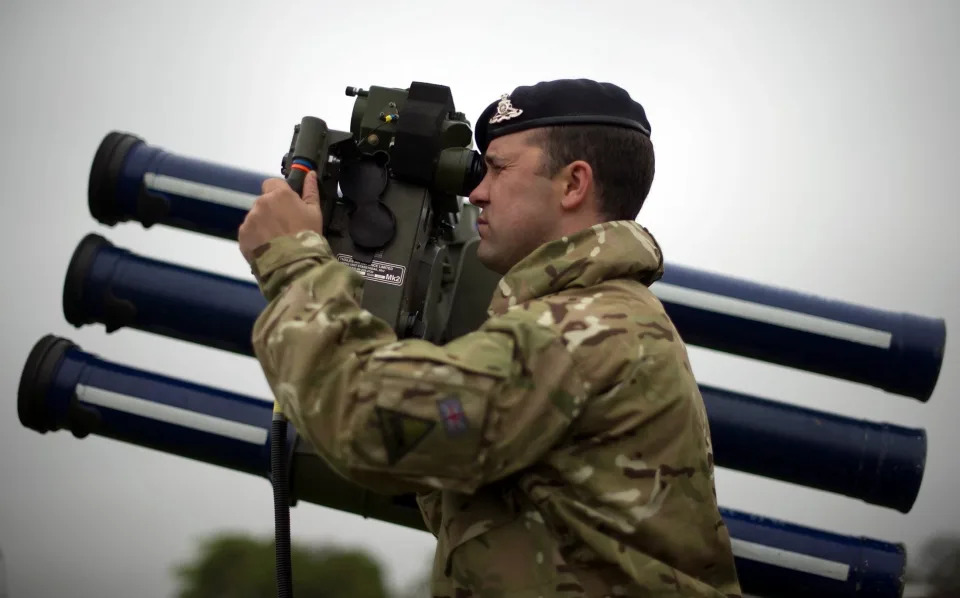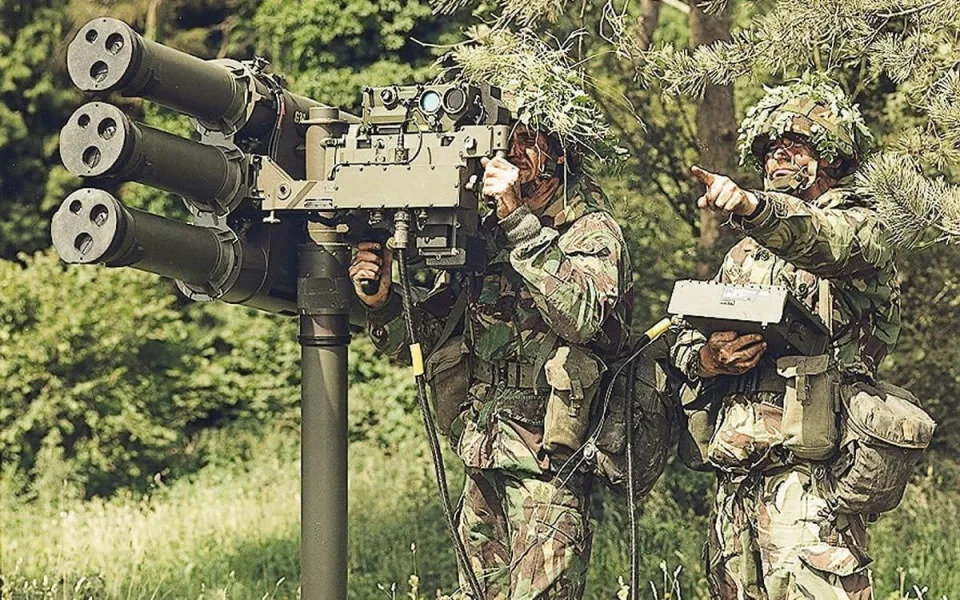The Telegraph
Britain to send world’s most advanced anti-aircraft missile system to Ukraine
Dominic Nicholls – March 9, 2022

Britain is set to send the world’s most advanced anti-aircraft missile system to Ukraine, the Defence Secretary has announced.
Ben Wallace on Wednesday told MPs he is looking at providing the Starstreak High-Velocity Missile systems to the Ukrainians, stepping up the UK’s military assistance to Kyiv.
Designed to destroy fighter jets and helicopters, Starstreak is the fastest short-range surface-to-air missile in the world, travelling at over Mach 3.
The missile uses three dart-like projectiles allowing multiple hits on the target. It can be fired from the shoulder, from a lightweight multiple launcher or from armoured vehicles.
Earlier versions of the system, which is made by defence firm Thales in Belfast, were deployed on top of tower blocks for the 2012 London Olympics, a move which caused some concern among residents.
As it was, no missiles were fired during the Olympic games.

The system relies on its immense speed to defeat aircraft manoeuvring around a battlefield.
‘Defensive’ lethal aid
Military officials hope the missile, described as “defensive” lethal aid by Mr Wallace, will help Ukraine gain control of the skies and further erode Russia’s fighter jet and helicopter fleets.
Once fired, the missile carrying the three darts uses a small charge to blast it clear of the launch tube. This motor cuts out before the missile has left the tube to prevent injury to the operator.
At about four metres from the soldier firing the weapon, a second booster fires to accelerate the missile rapidly to over Mach 3.
The missile homes in on the target aiming for two laser beams “painted” on the aircraft by the launch unit. All the soldier firing the weapon has to do is keep the target in the sights.
Three times the speed of sound

The target aircraft has no time to hide behind buildings or outrun the missile, which travels at more than three times the speed of sound.
Approaching the target, the three darts, known as “hitiles”, separate from the missile and coast towards the aircraft.
The kinetic energy generated by travelling at such speed will destroy most targets, but to ensure complete destruction each dart contains a delayed initiation 0.9kg blast fragmentation warhead that explodes inside the aircraft.Addressing the Commons, Mr Wallace explained the rationale for the potential donation of such missiles. “As the conflict intensifies, the Russians are changing their tactics, so the Ukrainians need to, too,” he said.
“We can all see the horrific devastation inflicted on civilian areas by Russian artillery and airstrikes, which have been indiscriminate and murderous. It is therefore vital that Ukraine maintains its ability to fly and to suppress Russian air attack,” he added.
Highlighting that the international community has already given man-portable air defence missiles, he said the Ukrainian forces’ capability “needs strengthening”.
Following requests for further help from Ukrainian President Volodymyr Zelensky, Mr Wallace said providing Starstreak will “allow the Ukrainian forces to better defend their skies”
He sought to characterise the weapon supplies as defensive and tactical in nature, so as to avoid handing Vladimir Putin an excuse to refer again to the potential use of nuclear weapons.
“Everything we do is bound by the decision to supply defensive systems and [is] calibrated not to escalate to a strategic level,” the Defence Secretary said.
However, in another sign that London is stepping up the level of support it is prepared to give, he announced that Britain is about to dispatch a “small consignment” of Javelin missiles to Ukraine.
The US and Estonia have already been supplying Kyiv with the infrared-guided anti-tank munitions. Ukraine has been sent a variety of arms that target tanks by the West, including Panzerfaust 3 anti-tank weapons from the Netherlands, and AT4 anti-missile launchers from Sweden.
Mr Wallace updated the Commons on other lethal assistance the UK has provided to the Ukrainians in the 14 days since the Russian assault commenced.
This includes 1,615 next-generation light anti-weapons known as “NLAWs”, on top of 2,000 of the missiles that were sent before Moscow invaded.
The Defence Secretary highlighted that body armour, helmets, boots, ear defenders, ration packs, range-finders and communications equipment had also been donated to Ukraine.
“We shall also be increasing supplies of rations, medical equipment, and other non-lethal military aid,” he said.
Britain was the first European nation to supply lethal aid to Kyiv, he said, adding that the UK has also “invested in building Ukrainian military capacity since 2015”, alongside the US, Canada and Sweden.
Reuters
Britain plans to supply Ukraine with anti-aircraft missiles – minister
March 9, 2022

LONDON (Reuters) – Britain is planning to supply Ukraine with anti-aircraft missiles to help it defend its skies from Russian invasion, defence minister Ben Wallace said, stressing that the technology fell within the definition of defensive weapons.
“It is vital… that Ukraine maintains its ability to fly and suppress Russian air attack,” Wallace told lawmakers.
“In response to Ukrainian requests, the government has taken the decision to explore the donation of STARStreak high-velocity man-portable anti-air missiles. We believe that this system will remain within the definition of defensive weapons, but will allow the Ukrainian force to better defend their skies.”
Wallace said the decision had been taken in principle to supply the systems, and the government was working out how to get them into Ukraine and train Ukrainian forces to use them.
The STARStreak system is made by Thales.
If confirmed, the supply would mark a significant step in Britain’s support for Ukraine. So far, Ukraine has praised Britain’s contribution of thousands of anti-tank missiles which have helped slow the Russian advance on Kyiv.
However Britain’s support has been limited to defensive weaponry.
“Everything we do is bound by the decision to supply defensive systems, and are calibrated not to escalate to a strategic level,” Wallace said.
As a member of the NATO military alliance, Britain has rejected pleas from Ukraine to impose a no-fly zone over the country. Britain says that could mean NATO forces shooting down Russian planes, resulting in a significant escalation of the conflict.
A proposed plan to allow Poland to donate fighter jets for use in Ukraine was rejected by the United States on Tuesday. Poland now says any supply of fighter jets to Ukraine must be done jointly by NATO countries.
Wallace said that was a matter for Poland.
(Reporting by Kylie MacLellan, writing by Alistair Smout; editing by William James, Michael Holden and Nick Macfie)
Defense News
Britain mulls giving ‘Starstreak’ air-defense weapons to Ukraine
Andrew Chuter – March 9, 2022

LONDON — Britain has stepped up its supply of weapons to the Ukrainian military, adding Starstreak anti-air missiles to a list that already includes significant numbers of anti-tank weapons.
Defence Secretary Ben Wallace told lawmakers Mar. 9 that the government was “exploring” the supply of Starstreak but later confirmed that the decision had already been taken in principle to provide the Thales UK-built, short-range weapon.
Issues such as training still had to be resolved, however, said the defense secretary.
Wallace also told Parliament that Britain would supply limited numbers of Lockheed Martin- and Raytheon-built Javelin anti-tank missiles alongside non-lethal items such as ration packs and medical supplies.
“We believe that this system will remain within the definition of defensive weapons but will allow the defending force to better defend the skies,” Wallace said, referring to the Starstreak capabilities.
Wallace told lawmakers that Russia was now using unguided bombs, and that with 95 percent of its forces around Ukraine committed, Moscow was trying to encourage private Russian troops from organizations like the Wagner Group to join the fight.
Citing Ukrainian data, he said Russia is believed to have lost 285 tanks, 985 armored vehicles, 44 aircraft, 48 helicopters, 109 artillery pieces. Some 11,000 Russian troops had been killed, he added, noting that the Ukrainian figures were unverified.
Starstreak is a high-velocity missile designed to provide air defense against helicopters, low flying fixed wing jets and unmanned air vehicles out to a range upwards of 4 miles.
The British have fielded the weapon since 1997, first mounted on an armored vehicle, but more recently as a lightweight, multiple-missile launcher and in shoulder-launched configurations.
Starstreak is the second significant weapon system supplied to the Ukrainian military by the British recently.
Just ahead of the Russian invasion Royal Air Force C-17 airlifters delivered Next Generation Light Anti-tank Weapons (NLAW) to Ukraine.
Like the Starstreak, the NLAW was built at a Thales UK factory just outside Belfast, Northern Ireland, although the anti-tank weapon was largely developed by Saab in Sweden as a collaborative effort between the two countries.
Wallace updated lawmakers on the volume of NLAWs supplied to the Ukraine, saying Britain had initially provided 2000 weapons but had now increased that number to 3615 missiles, with efforts continuing to deliver more.
The weapons are coming from British military stockpiles. Wallace said work was underway to replenish them.
The weapons supply is part of a wider aid contribution from the British, which includes a big increase in humanitarian donations by the government.
Although Britain is pouring money into aid and the supply of weapons Wallace didn’t address the broader issue of increased defense spending during his statement.
The government announced a £16.5 billion ($22.3 billion) increase over four years in 2021, but a yet-bigger increase would appear to have broad support across Parliament.
The parliamentary Defence Committee has been advocating a substantial rise in Britain’s underfunded military for several years.
A plan for increased spending could come as soon as the next few weeks.
How much is enough is a difficult question, said John Louth, an independent defense analyst here.
“They will have to consider going back to the 1980s spending levels if not before,” he added. “Certainly I can see it going up to 3.5% of gross domestic product [from 2percent now], maybe a little more. The lesson from the Cold War though is that it’s no good doing that unless you are taking an integrated approach with allies.”
Like other analysts here Louth reckons the government’s integrated defense review, released just 12 months ago, will need a rethink, if not shredding, in the wake of the Russian invasion.
Louth said rethinking the role and capabilities of Britain’s shrinking army Army was the immediate priority.
“The British Army have to wake up to the fact that the future isn’t going to be exquisite, highly technical stand-off weapons. It is probably going to be lots of people in traditional looking vehicles with the ability to maneuver. It changes the sense of the Army just being a recruiting ground for the special forces,” he said.
